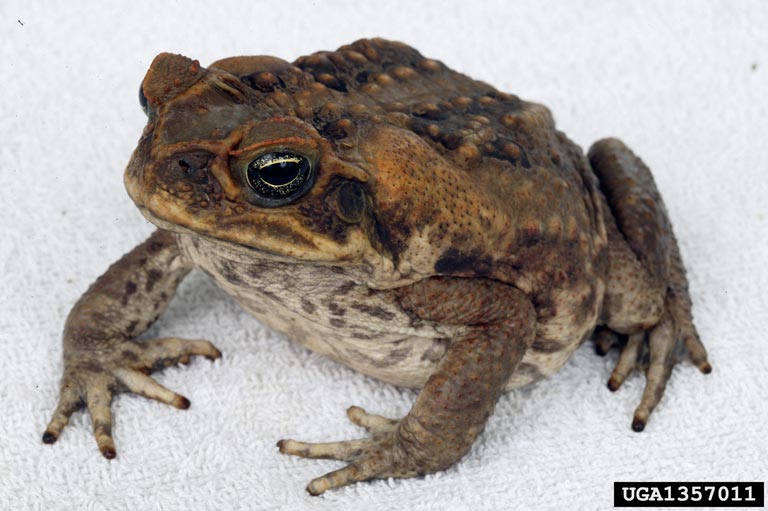EDRR Invasive Species
Cane Toad (Rhinella marina)
a.k.a Bufo toad, Marine toad
Define Invasive Species: must have ALL of the following –
- Is non-native to the area, in our case northwest Florida
- Introduced by humans, whether intentional or accidental
- Causing either an environmental or economic problem, possibly both
Define EDRR Species: Early Detection Rapid Response. These are species that are either –
- Not currently in the area, in our case the Six Rivers CISMA, but a potential threat
- In the area but in small numbers and could be eradicated
Native Range:
The cane toad is native to central and south America.
Introduction:
Cane toads were intentionally released into Florida in the 1930s as a biological control for a beetle that was consuming the economically important sugar cane crop. It is believed that the initial released population did not survive but additional released toads in the 1950s did.
EDDMapS currently list 1,102 records of this toad. All but five are reported from Orlando south. Three were reported in north Florida – one in the Gainesville area, one in the Villages, and one in Deltona area. Two have been reported in the Florida panhandle. A small population existed in Bay County for a period and one report came from Okaloosa County, which is the only report within the Six Rivers CISMA. This toad is still sold in pet stores, and it is most likely these were escaped pets.
Description:
This toad is much larger than our native toads. Florida’s native toads do not reach lengths greater than 4 inches, cane toads can reach 6 inches and possibly up to 9 inches. The are reddish-brown in color and have very large parotid glands (poison glands) on their shoulders. Native toad parotoid glands are typically oval in shape, the cane toads are triangular. The cane toad also possesses a ridged crest over the eye that our native toads lack.
Even in their native range, cane toads prefer human habitations and are often found around homes, gardens, schools, and in agriculture fields.
Issues and Impacts:
There are two primary concerns with this toad. (1) their voracious appetite, and (b) their toxicity to pets. Cane toads will feed on native frogs, lizards, snakes, small mammals, and anything else they can get into their mouths. In areas where cane toads are common, declines of the native southern toads have been reported. The poison secreted by this toad is highly toxic to pets. Though in most cases there is a lot of foaming and drool at the mouth, dogs have had seizures and have gone into cardiac arrest, even dying. The eggs and tadpoles of this toad are also toxic. Eggs laid in landscaped ponds typically kill the fish that inhabit them. The toxin is also highly irritable to humans. Wiping on the face or open cuts can lead to skin irritations and everyone should avoid wiping their eyes. It is recommended to handle these toads with gloves.
Management:
Hand capturing, using gloves, and humanely euthanizing cane toads found in your yard is the primary method of control. It is important to correctly identify the toad before euthanizing it. If you have questions, you can contact your county extension office.
To humanely euthanize wipe, or spray, benzocaine or lidocaine on the lower belly. This will act as an anesthesia to numb the nervous system and put the animal to sleep. The toad can now be placed in a zip lock bag and placed in the freezer. If you do not have products with benzocaine or lidocaine (often found in products to help with toothache or sunburns) you can place the toad in a zip lock bag for a few hours in the refrigerator, then move to the freezer. It is recommended if cane toads are present in your neighborhood to remove outdoor pet food and water bowls. If you do not wish to euthanize the toad you can contact a wildlife control business.
Please report any sighting to www.EDDMapS.org. There are biologists who verify the photograph you send. It is important that we keep track of this EDRR species.
For more information on this EDRR species, contact your local extension office.
References
Johnson, S. 2020. Florida’s Frogs and Toads. University of Florida Department of Wildlife Ecology. https://ufwildlife.ifas.ufl.edu/frogs/canetoad.shtml.
Wilson, A., Johnson, S. 2021. The Cane or “Bufo” Toad (Rhinella marina) in Florida. Electronic Data Information System publication #WEC387. https://edis.ifas.ufl.edu/publication/UW432.
Early Detection and Distribution Mapping System (EDDMapS)
Six Rivers CISMA
https://www.floridainvasives.org/sixrivers/
- Rattlesnakes on Our Barrier Islands; Part 3 – Envenomation - December 22, 2025
- St. Joe Red Tide Claiming Terrapins - December 15, 2025
- The 2025 Snake Watch Report for the Pensacola Bay Area - December 15, 2025

